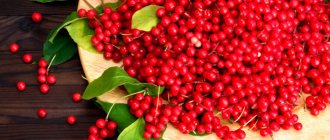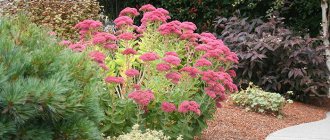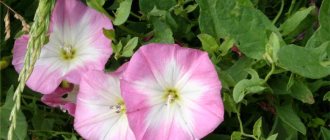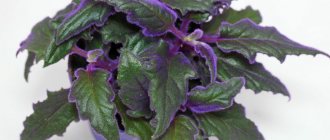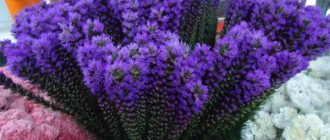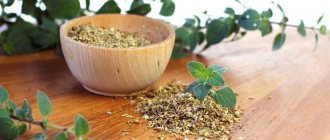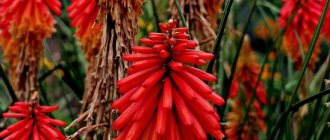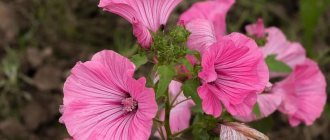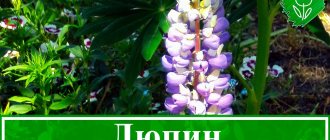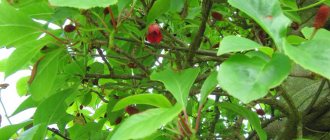The healing properties of Schisandra chinensis have been known for a long time, but attention has been paid to its decorative qualities relatively recently. Now the plant is widely used not only in folk and official medicine, but also in landscape design.
Its lignified deciduous vines, which reach 10 m in length, are used in vertical gardening. They look natural on arches, pergolas, fences and walls of houses and gazebos.
In the spring, Chinese schizandra, also called lemongrass, decorates the area with delicate white or pink flowers, in the summer it shelters from the sun with green foliage, and in the fall it adds color to the landscape with red fruits. The vine retains its attractiveness until winter.
3. Medicinal properties and contraindications
Similar to ginseng, lemongrass has many beneficial properties - its fruits are widely used in food. The Chinese were the first to notice the healing properties of plants and began to use it for medicinal purposes already in the 5th century AD.
Schisandra berries have a rich content - they contain organic acids such as citric, succinic, malic, tartaric, as well as pectin and vitamins P and C, tannins.
The leaves, shoots, and bark of plants are rich in essential oils, and special substances are found in the berries - phytohormones that can tone the body and withstand quite strong physical exertion. It was not for nothing that the fruits of lemongrass were eaten by Siberian hunters, and during the Great Patriotic War the fruits were mandatory in the diet of military pilots.
The plant is used to increase resistance to disease and stress, increase physical performance and endurance, prevent premature aging and increase life expectancy, normalize blood sugar and blood pressure, and improve immunity.
The effectiveness of herbal preparations based on schisandra has been proven in reducing cholesterol levels and treating diseases of the upper respiratory tract. With the help of this plant, they eliminate sleep problems (insomnia), relieve fatigue and irritability, and improve the condition of the gastrointestinal tract and liver. Schisandra seeds can regulate the acidity of gastric juice.
It is believed that plants have anti-inflammatory and antimicrobial effects, and also prevent the development of cancerous tumors and help remove toxins from the body.
↑ Up,
Schisandra berries contain a large amount of antioxidants and can stabilize cardiac activity and improve visual acuity, especially at night. Schizandra is also used for weight loss - by stabilizing metabolic processes in the body, it gives people strength and energy, forcing them to move more.
The seeds in the round red berries have the highest concentration of useful substances - they are collected in the fall, after full ripening. You should not take medicinal seeds uncontrollably - if the dosage is exceeded, symptoms such as nausea and vomiting are observed.
Contraindications include individual intolerance to the plant and possible allergic reactions. Schisandra should not be used during lactation or for treating children under 12 years of age. Also, contraindications to the use of plants may be increased acidity of gastric juice, sleep disturbance and increased excitability, increased arterial and intracranial pressure, and epilepsy.
It is not recommended to use it uncontrollably or exceed the dosage, since a large amount of consumed berries or lemongrass leaves can cause insomnia and headaches. It is better to take medications with this plant in the first half of the day.
↑ Up,
3.1.Collecting and preparing lemongrass
The collection time will depend on what kind of raw material will be used as a medicinal product. The highest concentration of useful substances in the bark is observed in early spring - it is at this time that it is worth collecting.
The leaves are collected young, when they have just reached their adult size, the berries are collected in September, after turning red and ripening. Checking the ripeness of the berries is very simple - with the slightest tap on the hand, they are easily separated from the stalks and fall off.
Drying different parts of plants should also take place differently. The berries are scattered on a hard surface and left in a warm place without direct sun to dry. Complete drying should take place in an oven or a special dryer at a temperature of about 40 degrees. Instead of drying, the berries can be frozen or mixed with granulated sugar.
Shoots and foxtails can be tied into small bunches and hung upside down, out of direct sunlight. After complete drying, the raw materials are collected in paper bags and stored in a cool and dry place.
↑ Up,
Chemical composition of the plant
In terms of its chemical composition, Chinese lemongrass is a very useful plant. It contains many vitamins and minerals beneficial to the human body.
This type contains the following substances:
- vitamin C - slows down aging, increases and strengthens the immune system;
- B1 - strengthens nerves, helps normalize intestines, improves skin condition;
- PP - lowers cholesterol in the blood, normalizes blood pressure;
- E - improves the condition of the skin, fights its aging;
- beta-carotene - prevents the formation of malignant tumors, normalizes the functioning of the heart muscle.
In addition to these components, the plant contains many elements, such as:
- zinc;
- iodine;
- manganese;
- potassium;
- iron;
- copper.
4. Planting and care
Growing lemongrass does not cause much trouble, but it is important to immediately choose a suitable location for the flower. The area should be illuminated by the morning sun and at the same time be in light shade during the daytime.
This vine does not like flooded lowlands or areas from which rain and melt moisture does not drain for a long time; areas with shallow groundwater are also not suitable. You should not plant the flower in places blown by strong winds, where there is often a cold draft.
4.1.When and how to plant lemongrass
Planting of seedlings in open ground is carried out in mid-May - it is at this time that the threat of the last night frosts in the central zone becomes minimal, and the soil warms up to the required 10º C. It is better to plant in the ground on a cool and cloudy day, and if the weather is warm, then can be postponed until the evening.
Plants 2-3 years old and 12-15 cm high are suitable for planting. For planting, it is worth choosing bushes with dormant growth buds - as soon as they wake up, the plant will take a long time to take root.
The area for the vine is carefully dug up using a spade and a week before planting, planting holes are prepared, the depth and width of which should exceed the root ball of the lemongrass bushes - approximately 50 - 60 cm. About 100 cm is left between the holes.
↑ Up,
At the bottom of the planting holes, a drainage layer is made of crushed stone, river pebbles or coarse expanded clay. The free space in the holes is filled with a soil mixture, into which turf and leaf humus, wood ash and potassium-phosphorus fertilizers are additionally mixed. After 1 - 2 weeks, the soil in the holes will settle and you can start planting the bushes.
The day before planting, water the plants very generously, completely soaking the soil in the pots. The seedlings are moved by transshipment, keeping the bark ball intact and placing it in the planting holes along with it. This method of transplantation allows the plant to quickly adapt to a new place and begin to grow.
If you purchased a seedling with an open root system, then you should make sure that such a plant has three root shoots at least 20 cm long.
If there are rotten or diseased sections, they are removed using pruning shears, roots that are too long are shortened to 22 - 25 cm. In order for the root system to be saturated with moisture, the day before planting, the plants are soaked in warm water with the addition of potassium permanganate and preparations such as Epin and Zircon.
↑ Up,
After soaking, the root system is dipped into a clay mash with the addition of well-rotted manure and air-dried for 2 hours.
At the bottom of the planting holes, a little soil is poured onto the drainage layer in the form of a mound and a seedling is placed on it with the roots straightened and directed downwards. Next, the bushes are sprinkled with soil and compacted well.
After planting, the flower should be at the same depth as in the container, and the root collar should be flush with the soil level or 2-3 cm above it.
↑ Up,
The planted vine is watered abundantly with warm water and the shoots are cut off, leaving only 2 - 3 growth buds. The leaf blades are removed completely or also trimmed, leaving only 1/3 of the length.
The bases of the plant are mulched with mowed grass, straw, rotted humus or sawdust. Mulch will protect lemongrass from weeds and help conserve moisture after watering.
In the first 7 - 10 days, the bushes are protected from direct sunlight and watered abundantly, keeping the soil evenly moist, but not swampy.
↑ Up,
4.2.Soil
Schisandra loves nutrient-rich substrates that easily allow moisture to pass through and allow the root system to receive oxygen. If the soil at the planting site does not meet these requirements, it can be easily corrected.
To improve the structure and drainage capacity, river sand is mixed into dense clay soils. In order for the plants to receive a sufficient amount of nutrients, the soil is enriched with well-rotted manure or humus.
A slightly acidic soil pH in the range of 5.5 to 6.5 is preferred.
↑ Up,
4.3.Support
This vine is grown only on a support - without it, the plants will remain small and will hardly exceed 80 - 100 cm in height. Such specimens will not bear fruit. Using lemongrass you can decorate gazebos and walls of buildings.
To grow vines, temporary structures can be provided - vertical supports, trellises. 2 lemongrass bushes, planted on different sides of a decorative arch located above the garden path, will look extremely decorative.
Flexible shoots can be secured using construction ties or special garden plastic clamps painted green. Tall shoots of lemongrass can also be simply thrown over the garden fence.
↑ Up,
It is best to build a support for lemongrass, similar to a trellis for grapes - take pillars about 3 m high and dig them into the ground at the same distance from each other.
A thick metal wire is stretched between the pillars so that its lower level is 50 - 60 cm above the surface of the substrate, the second at a height of about 150 cm, and the third about another meter higher.
As the vine grows, it is directed accordingly along the lowest wire, then along the middle and then along the highest.
↑ Up,
4.4.Water and fertilize
Young and newly planted plants will need regular and abundant watering. With age, lemongrass will better tolerate minor droughts, but during the period of formation of leaves and buds, watering should not be neglected. As the berries fade and form, the frequency of watering can be reduced slightly.
Watering is carried out early in the morning or in the evening - before sunset. At this time, water can go deep into the ground. When watering during the daytime, water evaporates too quickly from the soil surface, and if it gets on the leaves, it can even cause sunburn.
Since the vine develops a fairly large root system, each plant will need about 50 - 60 liters to be completely saturated with moisture. Schizandra does not like watering with cold water - it is better to use warm and well-settled water.
↑ Up,
Schisandra does not like intense heat, and abundant watering and spraying of the leaves, carried out in the morning or evening, can help the plants survive this time.
For abundant flowering and fruiting, plants will need timely fertilizing, which is carried out 2-3 times per season.
The first fertilizing after planting can be done only after 2 years - during this time the plants will have enough nutrition that was placed in the planting hole.
As the first spring feeding, you can use well-rotted organic matter or mineral compounds rich in nitrogen. Nitrogen will help the vine grow leaves faster. With the appearance of the first buds, it is worth switching to potassium-phosphorus fertilizers - elements that contribute to the formation of a large number of buds.
↑ Up,
As organic matter, plants are watered with a weak solution of chicken droppings, slurry from well-rotted horse or cow manure, and wood ash and coal are also added.
The third fertilizing is carried out mainly when growing in fairly poor soil - it is done after ripening and harvesting of the fruits using potassium-phosphorus fertilizers. After any feeding, the plants are watered with plenty of water.
↑ Up,
4.5. Care in autumn, wintering
Schisandra has enviable frost resistance and, when grown in the garden without shelter, can withstand frosts down to -20 - 30 degrees Celsius. The most common species in the Middle Zone is Schisandra chinensis.
The greatest danger to adult plants can only be posed by night frosts in spring, when young leaves appear on the shoots.
For young vines less than 4-5 years old, it is worth providing additional shelter for the winter. To do this, the plants are watered very generously with warm water, adding up to 80 liters under each bush, then removed from the support and the long shoots are laid on the ground.
The root system is hilled up, raising the soil high, and the vine is sprinkled with dry fallen leaves or spruce branches on top. As soon as snow falls, it is also sprinkled on the vine.
The shelter is removed in the spring, when the snow has completely melted and the temperature at night will exceed zero.
↑ Up,
4.6.Transplant
It is not recommended to replant adult plants - they react negatively to damage to the root system and suffer for a long time if they lose too much moisture during the replanting process.
It is also worth choosing the right time - during the period of flowering and fruiting, all the forces of the plants are spent on this process, so it is worth replanting the vine in early spring, before the formation of buds.
↑ Up,
In case of emergency, transplantation is carried out in cloudy, or better yet, rainy weather. Pre-prepare the planting holes and water them thoroughly.
The bushes are dug up together with a lump of earth and placed on a small piece of plastic film - this way you can carefully move the schizandra to a new place along with the earthen lump. Plants are planted in holes, then watered abundantly and the bases of the vines are mulched.
In the first 7 - 10 days after transplantation, protect from direct sunlight, and water abundantly and regularly during the first month. Overdrying of the soil during this period can threaten the plants with death.
↑ Up,
4.7.Pruning and formation of lemongrass
Formative pruning of male plants is carried out immediately after flowering, female plants - after the fruits have fully ripened. A sanitary haircut can be done at any time, as needed.
Most often, during sanitary pruning, shoots that have frozen over the winter are removed and this is done in early spring.
In the first 2 - 3 years, plants are allowed to take root and develop freely, cutting off only weak and dead shoots. The growth of the above-ground part during this period occurs quite slowly - the main forces of the plants are devoted to the formation of the root system.
↑ Up,
At the age of 4 - 6 years, the first formative pruning is carried out. From 3 to 6 stems are left for each bush, and the rest are cut off at soil level - this trimming is carried out after the leaves have completely fallen off in the autumn months.
Using a sharply sharpened and sterile garden tool - a knife or pruning shears - they shorten shoots that are too long, often leaving only 10 - 12 buds at the base. It will be possible to adjust the growth again in the first half of summer.
Unlike many other plants, Schisandra actively flows sap during the winter months and should not be touched at this time - after winter pruning, the plants may die.
↑ Up,
If necessary, also trim the root shoots. An exception to this rule is the period of plant rejuvenation - when the old skeletal shoot should be replaced with a young one, which is left in the root shoots. Branches that have been forming fruits for 3 years in a row must be completely removed - they are replaced with young shoots.
Without pruning, plants become too bushy and straggly, are often susceptible to fungal diseases and produce less fruit.
When the vine is over 15 - 18 years old, it is worth carrying out a radical rejuvenating pruning, leaving only 4 - 5 shoots entering the fruiting phase, and cutting the rest to the ground.
↑ Up,
Possible problems
Schisandra chinensis is one of the plants that react sharply to errors in care. And in order to know how to correct the situation in each specific case, you need to familiarize yourself with the most common problems.
Among them:
- Poor fruiting . The reason for this is insufficient illumination of the plant and dense plantings. To correct the situation, it is necessary to replant the vine taking into account the requirements of the culture.
- Insufficient formation of fruit buds . The problem arises when using a low vine support. Its optimal height is 3-4 m, which allows the vine to form a large number of overgrowing branches.
- Slow development of lemongrass . This crop reacts painfully to soil compaction. Therefore, it must be planted at a distance of 1.5 m from permanent paths.
5.Home care
Schisandra can be grown not only in the garden, but also at home. Plants are installed on a southeast or southwest windowsill. If the vine is large in size, then it is grown in a floor pot, in close proximity to the window.
Every 2 weeks, the pot is rotated around its own axis a quarter turn so that the vine does not stretch towards the light source and develops evenly.
Pruning and shaping are carried out more radically, maintaining a compact shape and removing old and diseased shoots.
Water the plants with water at room temperature until the soil is completely soaked. After watering, excess moisture is immediately removed from the pan.
↑ Up,
Plants prefer to be in well-ventilated areas without cold drafts. There should be sufficient air movement in the rooms at all times.
In the warm season, pots with lemongrass are taken out into the fresh air - into the garden, placed under the shade of trees or on the balcony. You should not immediately change the location of the flower - the plants are accustomed to any changes gradually, over the course of a week.
Since a flower in a pot has a limited feeding area, for proper development and flowering it will need regular feeding, which is carried out from spring to autumn. Fertilizers are applied to moist soil immediately after watering.
The main difficulty in growing lemongrass is the cool dormant period. In autumn, after leaf fall, the frequency of watering is reduced so that the vine is in a barely moist substrate.
The air temperature is gradually lowered over the course of a week to 4 - 6 degrees Celsius - you can send the plants to the basement or take them out to an unheated balcony.
In the spring, with the first signs of new growth, the flower is taken out of the basement and brought into a warm room, the pot is placed in a bright place.
As with growing outdoors, plants must be provided with support.
Transplantation into new soil is carried out every spring. For young bushes, gradually increase the size of the pot when transplanting. For adult tub plants, the transplanting of which is difficult due to their size, it is enough to replace the top layer of soil 5-7 cm thick in the spring with a fresh soil mixture.
↑ Up,
Interesting Facts
- Schisandra is often used for decorative purposes. It makes excellent hedges that can decorate a gazebo.
- Due to the fact that vines form a dense layer of leaves, lemongrass is often used as a natural barrier to frosty winds.
- The fruits combine a whole kaleidoscope of flavors. Gourmets distinguish not only sour and sweet, but also balsamic flavor.
- The berry is used in cooking to prepare sauces for various dishes.
- In China, a decoction of lemongrass has long been used to relieve headaches.
We examined in detail the features of lemongrass, learning a lot of interesting things about it. First of all, the plant is a medicinal plant, playing the role of a powerful tonic. At the same time, it can become an interesting decorative element for your local area. And despite the fact that lemongrass is quite difficult to plant and grow, the benefits of its fruits will more than pay off all the efforts.
In this form, an experienced gardener talks about the use of lemongrass.
6.Reproduction
There are many ways to propagate Schisandra - this includes growing from seeds and vegetative propagation using air layering, stem cuttings, and root suckers.
6.1.Growing from seeds
Schisandra is quite easy to grow from seeds, which you can collect yourself from fully ripened berries. The berries are crushed by hand and the seeds are washed from the remaining pulp with running water.
The washed planting material is laid out on sheets of paper in a warm and ventilated room to dry. After complete drying, the seeds are collected in paper bags or fabric bags stored in a dry, cool place and used throughout the year. After this period, seed germination will decrease.
Before sowing, the seeds are soaked overnight in warm water, and stimulating drugs - for example Zircon or Epin - can be added to the water 1 - 2 hours before sowing.
↑ Up,
The outer hard shell of the seeds can be scarified - gently scratched with sandpaper, being careful not to damage the internal contents.
Instead of scarification, you can carry out cold treatment - stratification. For this period, 2 months before sowing, the seeds are placed in bags with slightly damp peat in the vegetable compartment in the refrigerator. After a period of stratification, the surface of the seeds may even crack.
Sowing is carried out at the end of winter - beginning of spring, in small separate pots with drainage holes, placing 2 - 3 seeds in each.
Drainage is placed at the bottom of the pots and filled with slightly moist, crumbly and nutritious substrate with the addition of river sand. The seeds are sown and covered with a layer of soil 5-10 mm thick. and thoroughly moisten the soil surface with a spray bottle.
To maintain high air humidity, pots with seedlings can be covered with plastic wrap or covered with transparent plastic. Place such pots in a warm and well-lit place, but small sprouts should not be exposed to direct sunlight.
The shelter is raised every day, ventilating the plants and wiping off accumulated water condensation. The ventilation time is increased daily, and with the appearance of the first shoots (within 2 - 2.5 weeks) the shelter is completely removed.
The last shoots may appear even 2 - 2.5 months after sowing. During the first month, maintain uniform soil moisture using a spray bottle, and after 2-3 waterings, add a few grains of potassium permanganate to the water.
If all the plants in the pot have sprouted, then get rid of weak shoots by pulling them out with tweezers and leaving only 1 bush per pot. As the vine grows and develops, larger containers are selected, transferring small plants by transshipment.
After each transshipment, 7-10 days later, the vines are fed with nitrogen fertilizers in a very low concentration. Within 1 year, the bushes add only 5 - 6 cm in height.
↑ Up,
Such plants are planted in open ground only 2 years after sowing the seeds, and the first buds and berries should be expected when the vine is 3-4 years old.
Sowing in open ground is carried out before winter - in mid-autumn. When sowing in autumn, the seeds will undergo cold stratification under natural conditions, and this will help to increase seed germination. The first shoots may appear in the spring.
Before planting home seedlings in the garden, they are hardened by leaving them outside during the daytime and gradually increasing the duration of such time over 2 weeks.
↑ Up,
6.2.Cuttings
Cuttings are carried out using both stem and root cuttings. Stem cuttings are taken in early summer using young shoots. The length of the cuttings can reach 10 - 12 cm and have 2 - 3 internodes.
The leaf blades of cuttings are shortened by half their length to reduce moisture loss. The bases of the cuttings are immersed in rooting powder, and then 1–2 cm deep in well-moistened soil or wet river sand.
The cuttings are covered with a transparent film on top, creating greenhouse conditions and placed in a warm, well-lit place, but inaccessible to direct sunlight.
After 2 - 3 weeks, if these agricultural techniques are followed, it will be possible to observe the appearance of the first young leaves - and this, in turn, indicates that the first roots have appeared under the surface of the earth.
When transplanting, you can separate the lateral shoot from the root system, cut it into cuttings about 10 cm long, and in each such part there should be 2 - 3 renewal buds.
The wound surface is treated with charcoal powder or wood ash for disinfection and drying. The rhizomes are soaked in dissolved rooting powder for several hours.
Planting is carried out in open ground, sprinkled with a layer of soil about 3 cm thick on top and watered abundantly.
↑ Up,
6.3.Formation of air layers
In early spring, as soon as the snow melts on the site, shallow grooves are dug near the lemongrass bushes and 2-3 year old, non-lignified lateral shoots located closer to the ground are placed in them.
Air layering is pinned to the surface of the soil and sprinkled with a layer of earth 10 - 15 cm thick. The soil in this place is kept evenly moist throughout the summer. The tip of the shoot must remain above the soil surface for photosynthesis. After 2 - 3 months, you will be able to observe how young shoots appear from underground.
With this method of rooting, several bushes can be formed from one layer at once, because the root system is formed in each buried leaf node.
You shouldn’t be greedy and dig up the entire length of the shoot - it’s worth remembering that the more leaf nodes are buried, the slower the formation of new plants will occur.
It will be possible to completely separate such cuttings from the mother plant only after 2 - 3 years.
↑ Up,
6.4.Separation of root shoots
Basal shoots are daughter plants that form on the root system of the mother adult bush - on a side branch located close to the soil surface.
In the first half of summer, such shoots are separated with a shovel, the wounds are treated with wood ash and immediately planted in a new, permanent place. As with transplantation, the offspring are watered abundantly and protected from direct sun.
Botanical description
The herb Schisandra is a deciduous vine 10-15 m long with a stem curling along the support, about 2 cm in diameter, covered with dark brown flaky bark. The bark on the shoots of the plant is smooth and yellowish. Schisandra leaves are up to 10 cm long and up to 5 cm wide, dense, with a pointed apex and wedge-shaped base, unclearly toothed along the edges, glabrous and dark green above and pale, slightly pubescent along the veins on the underside, located on pinkish-red petioles 2-2 long. 3 cm. Both stems and leaves emit a lemon aroma. Schisandra flowers are up to 1.5 cm in diameter, dioecious, with the same distinct aroma, white from the beginning of flowering, but gradually turning pink, located on drooping stalks in the leaf axils. Schisandra fruits are clustered racemes of many berries (multifoliates) up to 10 cm long, consisting of juicy red berries in which schisandra seeds ripen.
Flowering begins in May or June and lasts 10-14 days. Schisandra berries ripen in September. The berries are used to make jelly and jams, prepare soft drinks, and in the confectionery industry they are used to make fillings for sweets. The juice of the plant is used for bouquets of wines; tea is brewed from the bark and leaves of the plant. Schisandra fruits are medicinal raw materials.
7. Diseases and pests
Plant diseases may suffer from leaf spot, phyllostictosis, ramularia, and ascochyta blight. With high air humidity, low air temperature and insufficient movement, powdery mildew may appear. High humidity also contributes to the occurrence of fusarium.
Among the harmful insects, slugs and snails can attack plants.
↑ Up,
Support
A support is placed under the Chinese lemongrass. Trellis - special gratings - are most suitable for this. They are made of wood, metal, plastic, etc. The length of the ground part of the structure should be about 2.5 m. The lattice is installed immediately after planting young shoots. Instead of trellises, inclined stairs are also used.
Attention! Without support, Chinese lemongrass is mistaken for an ordinary shrub. In this case, you can’t count on a harvest.
Place a lattice or ladder under Chinese lemongrass
Trellis prices
Trellis lattice
8.Types and varieties of lemongrass:
8.1.Chinese or Far Eastern lemongrass - Schisandra chinensis
The most common species in Russian gardens, which is distinguished by excellent healing properties, high frost resistance and unpretentiousness. Dioecious perennial vines with shoots up to 10 m long. Modern breeders have developed self-fertile varieties based on this species, which form berries regardless of pollination.
↑ Up,
Benefit
The Chinese discovered the beneficial properties of lemongrass 15 centuries ago. In Russia, the plant began to be used in the 19th century. Modern people owe the discovery of lemongrass to Vladimir Komarov, a researcher of the Far East, who discovered that the berries and leaves, as well as the roots of the tree, are used everywhere. Schisandra is now used in pharmacology and is part of many drugs, including those used in military affairs.
Schisandra contains essential oils, citric, tartaric and ascorbic acids, sugar, many macro- and microelements, vitamins (in particular E and P). The main feature of the fruit is its tonic effect. In this regard, doctors recommend eating berries to restore strength. Schisandra is also used to treat many diseases, including asthma, neurasthenia, and it also helps reduce the effect of seasickness. For diabetics, consumption of berries will help lower sugar levels, and for sailors it will serve as an excellent remedy in the fight against scurvy. During World War II, lemongrass was used as a wound healing agent.
How to collect fruits
The lemon tree begins to actively bear fruit only after 4-6 years. The white flowers are replaced by clusters of fiery berries that exude a citrus aroma. You need to remove them with a whole brush, and then separate each berry from the cutting separately.
Determining the maturity of the fetus is not so difficult. If you lightly flick the bunch with your fingers, the ripe and ready-to-eat berries will fall off. The harvest period occurs at the beginning of autumn.
The use of medicinal berries is very diverse: they are used to make compote, jam, homemade alcoholic drinks, medicinal tinctures and eaten fresh. The leaves and branches along with the bark can be dried and used as tea leaves.
But the berries are stored for only a few days, so you need to quickly find a use for them so that they do not spoil.
In the Urals
The Urals belong to the temperate climate zone, like most of Siberia. Here, planting should be taken as responsibly as possible, since an already planted plant should not be attacked by cold weather. The soil of the seedlings should not become colder than 10 degrees, otherwise they may die.
The time itself falls at the end of April - beginning of May. To avoid unpleasant consequences, you can cover the permanent place for the growth of vines with an organic cloth, after loosening the soil. This will help keep you warm.
For active growth of lemongrass, you need to plant it on the sunny side. In the conditions of the Urals and Siberia, the plant must receive nourishment from the sun constantly.
Here gardeners recommend using a variety of Chinese lemongrass called “firstborn” for planting. It is more frost-resistant, but in winter it is still better to cover young shoots with a layer of leaves.
Trimming
Chinese lemongrass is pruned after two years. Up to 6 shoots are left in the bush, the rest are cut to the ground. After 16–18 years, the yield of the branch decreases, and it is also removed. The bushes are cleared in November. But such work is also carried out in June, if the vine is very overgrown.
Attention! Branches should not be trimmed in winter or late spring. This leads to the release of juice and the death of the plant.
Root shoots are removed every spring by cutting below the soil surface.
Schisandra chinensis pruning scheme
On South
Here, due to the hot climate, the conditions will be as comfortable as possible for the growth of Chinese vines. The landing time often falls in September or even early October. This time period is due to the almost complete absence of severe winters, the onset of which requires a well-developed root and complete adaptation to the weather.
As elsewhere, in the southern regions you need to carefully examine the roots of the future tree before planting. Their length needs to be adjusted to 20-25cm, and dried or rotten parts must be removed.
There is nothing impossible or supernatural in the process of placing young shoots in your garden. In comfortable conditions, seedlings quickly adapt to the terrain, and in a few years it will be possible to harvest the first harvest from the flexible branches of their wards.
Features of fruiting: two main questions about lemongrass
Is it enough to have a lemongrass plant on the site?
For normal fruiting, you need to plant several copies of lemongrass. Plants can be of three types: male, female and monoecious (plants bear flowers of both sexes each year). Moreover, monoecious specimens have an unstable ratio of female and male flowers: that is, one year there may be both, but the next year most or all are female.
The presence of flowers of one sex or another depends on the age of the vine (young specimens form predominantly male flowers, female ones appear later) and growing conditions. Therefore, if you plant only monoecious specimens, it is difficult to guarantee an annual harvest. It is better to plant dioecious plants along with monoecious plants.
How can you tell which lemongrass plant you have?
Male and female plants can only be distinguished during flowering: the female flower has a large greenish pistil, the male flower has three stamens.
In addition, on the shoots of monoecious specimens, female flowers are formed mainly in the upper part of the vine, and male flowers - in the lower part.
Male flowers of Schisandra chinensis
Female flower of Schisandra chinensis
